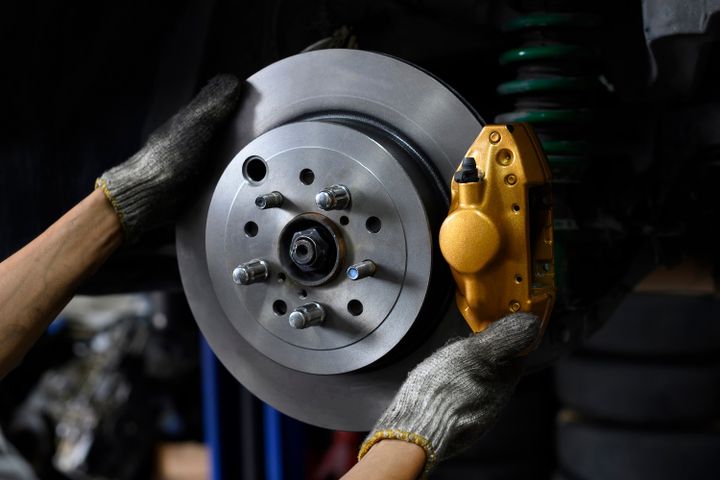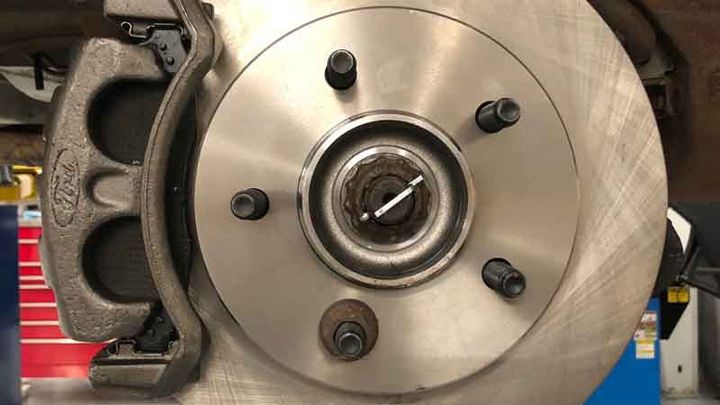


Brake discs are a crucial component of a vehicle's braking system, playing a vital role in ensuring safe and efficient deceleration. They are responsible for converting the kinetic energy of a moving vehicle into thermal energy through friction, ultimately slowing down or stopping the vehicle.
The brake discs work in conjunction with the brake pads, which are pressed against the discs when the brake pedal is applied. As the pads clamp onto the rotating discs, the resulting friction generates heat, dissipating the vehicle's kinetic energy and causing it to decelerate.
Brake discs are designed to withstand extreme temperatures and immense pressure, making them a critical safety feature. They must be able to consistently and reliably provide the necessary braking force, even in demanding situations such as emergency stops or sudden maneuvers.
Furthermore, brake discs contribute to the overall braking performance and handling characteristics of a vehicle. Well-maintained and properly functioning brake discs ensure consistent and predictable braking, allowing drivers to maintain control and respond effectively to changing road conditions.

Brake discs are subjected to immense stress and friction, leading to inevitable wear over time. However, several other factors can accelerate the need for replacement:
| Cause | Description |
|---|---|
| Excessive Wear and Tear | Even with regular maintenance, brake discs will gradually wear down due to the constant friction generated during braking. As the disc material thins, it becomes less effective at dissipating heat and providing sufficient braking force. |
| Warped or Grooved Discs | Overheating, caused by aggressive braking or towing heavy loads, can lead to warping or grooving on the disc surface. This uneven surface can cause pulsation in the brake pedal and uneven pad wear. |
| Cracks or Damage | Impact from road debris or accidents can result in cracks or damage to the brake discs, compromising their structural integrity and braking performance. |
Worn, warped, or damaged brake discs can manifest in various ways, such as vibrations, squeaking noises, longer stopping distances, and uneven brake pad wear. Ignoring these signs can lead to more severe issues and potential safety hazards.
As a professional mechanic, I follow a thorough inspection and diagnosis process to identify brake disc issues. This process includes:
Visual Inspection: Carefully examining the disc surface for signs of grooves, cracks, or uneven wear patterns.
Thickness Measurement: Using specialized tools, measuring the disc thickness against the manufacturer's minimum specifications to determine if it falls within the acceptable range.
Runout/Warping Check: Attaching a dial indicator to the disc to detect any excessive runout or warping beyond the specified tolerances.
Noise Evaluation: While the vehicle is on a lift, listening for any squeaking or grinding noises during brake application, which can indicate disc issues.
Common signs of worn or damaged brake discs include:
Grooves or scoring on the disc surface
Cracks or lip formation on the outer edges
Excessive runout or warping beyond tolerances
Disc thickness below the minimum specifications
In most cases, replacement is the best solution for worn or damaged brake discs. However, resurfacing (machining) may be an option for minor wear or warping within specified limits.
The replacement process involves the following steps:
Safely lifting and supporting the vehicle
Removing the wheel, caliper, and brake pads
Removing the old disc and cleaning the mounting surface
Installing the new disc, ensuring proper alignment and torque
Reinstalling the caliper, pads, and wheel
Bedding in the new discs per the manufacturer's instructions
It's crucial to replace discs in axle sets to ensure even wear and optimal braking performance. Additionally, I always recommend using quality replacement discs from reputable brands to ensure longevity and reliable performance.
During the replacement process, I also inspect and replace other brake components, such as pads, calipers, or rotors, if necessary, to ensure the entire braking system is functioning correctly.

While brake disc replacement is sometimes unavoidable, there are several preventive measures you can take to extend their lifespan:
Regular Brake Inspections: Follow the recommended maintenance schedule for your vehicle and have your brakes inspected regularly by a professional mechanic. This allows for early detection and prevention of potential issues.
Avoid Aggressive Braking: Excessive heat buildup from aggressive braking can warp or damage the discs. Practice gentle braking whenever possible, and avoid situations that require frequent hard braking, such as tailgating or sudden stops.
Proper Bedding Procedure: After disc replacement, follow the manufacturer's recommended bedding procedure to ensure proper pad and disc mating. This process involves a series of controlled braking maneuvers to gradually transfer a thin layer of pad material onto the disc surface, creating a stable friction surface.
Consider Upgrading: For high-performance or heavy-duty applications, consider upgrading to higher-quality, performance brake discs designed to withstand more extreme conditions. These discs are typically made from more durable materials and have better heat dissipation properties, reducing the risk of warping or cracking.
The cost of brake disc replacement can vary significantly depending on several factors:
| Factor | Description |
|---|---|
| Vehicle Make and Model | The cost of replacement discs and other components can vary greatly between different vehicle makes and models. |
| Quality of Replacement Discs and Pads | Higher-quality discs and pads from reputable brands tend to be more expensive but offer better performance and longevity. |
| Labor Costs in Your Area | Labor rates can differ significantly based on your geographic location and the specific repair shop. |
| Additional Component Replacements | If other brake components, such as calipers or rotors, need to be replaced, the overall cost will increase. |
On average, you can expect to pay:
$100 - $300 per axle for basic replacement discs and pads
$200 - $500 per axle for higher-quality discs and pads
Additional labor costs of $100 - $200 per axle
Replacing all four discs and pads can cost anywhere from $400 to $1,200 or more, depending on the vehicle and the quality of parts used.
It's essential to consider the long-term benefits of using quality replacement parts. While they may be more expensive initially, they can provide better performance, longer service life, and improved safety, potentially saving you money in the long run.
Properly functioning brake discs are crucial for safe vehicle operation and should never be neglected. As a professional mechanic, I cannot stress enough the importance of addressing brake disc issues promptly and following proper maintenance procedures.
By understanding the common causes, inspection and diagnosis processes, repair methods, and preventive measures, you can make informed decisions about brake disc replacement and ensure the longevity and safety of your vehicle's braking system.
Remember, it's always recommended to seek the expertise of a reputable repair shop and obtain quotes for brake disc replacement. Investing in quality parts and professional installation can provide peace of mind and ensure your safety on the road.
Resurfacing (machining) may be an option for minor wear or warping within specified limits. However, if the discs are excessively worn, cracked, or damaged beyond the acceptable limits, replacement is necessary.
It is generally recommended to replace brake discs in axle sets (both front or both rear) to ensure even wear and optimal braking performance. Replacing only one disc can lead to uneven braking and premature wear.
Follow the recommended maintenance schedule for your vehicle, which typically suggests having the brakes inspected every 12,000 miles or annually, whichever comes first.
Signs of warped or grooved discs include vibrations in the steering wheel or brake pedal, squeaking or grinding noises during braking, and uneven brake pad wear.
While it is possible to replace brake discs as a DIY project for experienced mechanics, it is generally recommended to have a professional handle the job to ensure proper installation, alignment, and bedding procedures.
The lifespan of new brake discs can vary greatly depending on factors such as driving habits, vehicle weight, and the quality of the discs. On average, high-quality discs can last between 30,000 to 70,000 miles with proper maintenance.
Performance brake discs are typically made from more durable materials and have better heat dissipation properties, reducing the risk of warping or cracking. They are recommended for high-performance or heavy-duty applications.
It is generally not recommended to reuse old brake pads with new discs. The old pads may have worn unevenly and may not mate properly with the new disc surface, leading to uneven braking and premature wear.
Follow the manufacturer's recommended bedding procedure, which typically involves a series of controlled braking maneuvers to gradually transfer a thin layer of pad material onto the disc surface, creating a stable friction surface.
While it is possible to mix and match different brands of discs and pads, it is generally recommended to use components from the same manufacturer or those designed to work together for optimal performance and compatibility.

Sarah isn't your average gearhead. With a double major in Mechanical Engineering and Automotive Technology, she dived straight into the world of car repair. After 15 years of turning wrenches at dealerships and independent shops, Sarah joined MICDOT to share her expertise and passion for making cars run like new. Her in-depth knowledge and knack for explaining complex issues in simple terms make her a valuable asset to our team.



